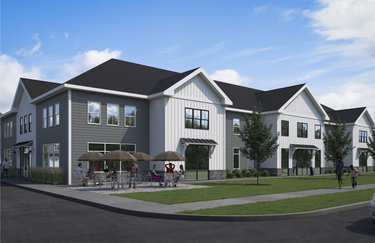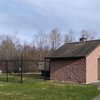Dutch Mill Acres allowed to proceed after town board split vote
GUILDERLAND — The new developers of the long-stalled Dutch Mill Acres housing proposal eked out a win this week after the Guilderland Town Board voted, 3 to 2, to accept developers Michael Fiacco and Jared George’s application for a zoning change of 3633 Carman Road.
As the board began its discussion of the 107-unit proposal on Nov. 18, Supervisor Peter Barber said, “I always like to use an analogy to baseball because I think at this step we’re not even in the first inning. This is simply just to accept the application, meaning that we're not approving it.”
Barber went on, “We’re allowing it to now be reviewed by the planning board, which will get into the site plan, traffic study … density, size, and whatnot. This is simply just a determination that [Town Planner Kenneth Kovalchik] and his team and the planning board can start looking at this and get it more detailed.”
Barber said the project would be back before the town board at least twice more, “probably sometime next year,” reiterating, “We are basically at the very, very beginning of this process. This is not an approval. This is simply just to let it go on to be reviewed.”
To get built, the project needs the zoning of the 16-acre property changed from general business to a Planned Unit Development district, a recommendation made by the town when the project was first proposed by Rosetti Properties in 2019. Planned Unit Developments requires a rezone through the passage of a new local law. The town board is the lead agency on PUD applications.
The three affirmative votes came from Supervisor Peter Barber and councilmen Jake Crawford and Gustavo Santos. The two dissenting votes were cast by Councilwoman Amanda Beedle and the outgoing deputy supervisor, Christine Napierski, who was elected town justice earlier this month; her spot on the board will be filled in January by Zoning Board of Appeals member Kevin McDonald, who ran unopposed for the seat.
Napierski’s concerns were mainly about the size and the density of the proposal. She also stressed that, when residents bought their homes, the area was, and is, zoned General Business, and those homeowners have a right to rely on the board “not to go changing that zone on them without a really, really good reason.”
She argued that, while a national housing shortage exists, Guilderland has seen a number of apartments come online recently, including two developments — one at Crossgates and the other at Hamilton Parc, which is for residents age 55 and older.
Napierski also noted the Foundry Square proposal, but contrasted her support for that project with Dutch Mill Acres because the Foundry Square site contains a brownfield, a row of dilapidated buildings, and a dangerous intersection all of which could be solved or improved if Foundry Square is built.
The project’s scale gave Beedle “great pause.”
Beedle voiced disappointment that the development team had offered certain benefits but then “start retracting,” citing as an example the percentage of units set aside for workforce housing declining from 15 to 10 percent since September, when Fiacco and George informally presented the project to residents.
At the time, the developers were also proposing more units, 125. The dual decline translates to a net loss of eight workforce-housing units, from 19 to 11. The developers noted the percentage was lowered because the total unit count was reduced.
Beedle’s vote was also influenced by what she heard from the project’s nearby neighbors on Danna Joelle Drive and Lone Pine Road. Those concerns, Beedle said, from existing town residents, were given additional weight as part of her decision-making process.
Crawford was comfortable moving the project forward, he said, but stressed there is “still a lot of work that needs to be done,” and added that he’d like to see a “compromise between the neighboring property owners and the project.”
While acknowledging the property's recent neglect, he expressed hope that the new developers would prove to be better stewards of the land moving forward, urging Fiacco and George to expand the project's mixed-use components and further enhance buffers, specifically suggesting the addition of a berm with tall trees to maximize privacy.
Crawford also emphasized the importance of maintaining “darker skies” to protect neighbors on Lone Pine and Danna Joelle from light pollution.
History
In 2019, Rosetti Properties was before the town’s development planning committee, seeking feedback for its a 12-building, 120-apartment proposal called Dutch Mill Acres. The parcel is the only property for miles zoned General Business, which Rosetti at the time was seeking to change to allow for more multi-unit development on the site.
Town staff in 2019 said there may not have been support for the zone change, based on the Fort Hunter and Carman Road neighborhood Transportation Plan, one of a number of neighborhood-specific studies recommended as part of Guilderland’s last adopted comprehensive land-use plan, in 2001.
The proposal was ultimately denied by the town board, which led Rosetti to come back in February 2020 seeking a 132-unit apartment and townhouse development, proposing five apartment buildings, each consisting of 20 units, and eight townhome-style buildings with four units each as well as 3,000 square feet of commercial space.
By January 2021, having previously come to the town with plans that included more units but were out of sync with Guilderland’s intended development goals for the area, Rosetti’s request was to build a 96-unit townhome development. The plan was panned by the town’s land-use advisory committee at time since 98 percent of total buildout was for housing.
Current proposal
Now, Fiacco and George are proposing to build 107 residential units in 16 buildings no greater than 35 feet in height, specifically:
— Eight two-story buildings containing four units each;
— Five two-story buildings containing eight units each;
— One two-story building containing six units;
— One two-story building containing 13 units; and
— One two-story building containing 16 units and 6,000 square feet of commercial space.
The development duo’s pitch focused on the project’s alignment with town planning goals, its fiscal benefits, their own responsiveness to community concerns regarding traffic and density, and 1,800 feet of new sidewalk.
The pair highlighted their project’s features and amenities like a clubhouse with a fitness center and community room, an outdoor patio with fire pits and grilling stations, and a “mail kiosk.” Also, all first-floor units are designed to comply with the Americans with disabilities Act.
In response to previous inquiries, the pair confirmed the inclusion of a flex court for activities such as for pickleball; a community garden; and a playground located near the front of the property.
The developers made the case that the project implements the recommendations of the Fort Hunter/Carman Road Neighborhood Transportation Plan, which identified this parcel as a prime candidate for higher-density development, and that it also supports the town’s pro-housing designation and Smart Growth principles, which is meant to reduce sprawl.
Fiacco and George proposed setting aside 10 percent of units for individuals who earn 80 percent of the area median income, which going by the definition recently adopted by the Guilderland Industrial Development Agency, would be $65,000 per year (based on an AMI of $81,300).
But this workforce housing proposal won’t win Fiacco and George any fans in the IDA, which adopted a 25-80 rule earlier this month, meaning at least 25 percent of units are to be set aside for individuals who earn 80 percent of the Albany County area median income. In order for the developer to apply for assistance from the IDA.
Fiacco and George said market-rate apartments in their project would go for $1,800 per month, but a workforce-unit rate was not disclosed. To bolster their argument about the need for their rentals, Fiacco and George argued that owning a $400,000 starter home created a monthly expense of over $3,000, making their high-quality rentals a necessary alternative for the workforce.
They also presented a cost breakdown, showing that a new single-family home costs approximately $535,000 to build before profit.
The developers argued that their project would be both fiscally efficient and financially beneficial to the town, claiming that, at full build-out, the project would generate over $415,000 annual tax revenue, compared to $11,835.
But, as is the case with 3633 Carman Road, that $415,000 in total revenue will find its way into nine different tax buckets — the town’s general fund, its highway fund, Albany County, fire, water, sewer, sewer operation and maintenance, school, and library — so the town’s coffers, meaning its general and highway funds, would increase by about $20,000 at full build-out, compared to the approximately $575 received for tax year 2025.
Addressing an issue that dominated their September presentation, Fiacco and George offered an October 2025 traffic study based on September counts that found daily traffic on Carman Road had actually decreased by 1.42 percent over the last decade; a recent count showed approximately 12,000 vehicles traveled the road daily.
The public
Fiacco and George have done a good job garnering support for their proposal, with some two dozen letters in favor of the project submitted to the board before the Nov. 18 meeting, at which 16 residents spoke during the public-comment period. For every speaker in opposition to the proposal, there were two who spoke in its favor.
Robyn Gray questioned why it should be a planned unit development, saying, “So what’s the point of having a PUD versus leaving it as general business?” Gray, who chairs the not-for-profit advocacy group, the Guilderland Coalition For Responsible Growth, said the town had “failed miserably” with PUDs, citing Costco.
“Supposedly, this development is going to support housing needs and demographics for those who want to downsize, but at what cost?” Gray asked. She said the market rate in Guilderland is about $1,600 per month for apartment rentals and the Dutch Mill apartments would cost more than that at $1,800 per month.
“Right now, Guilderland has over 550 vacant apartments in town,” said Gray, questioning the need for more.
Gray also called for a new traffic study, noting that the one reference is from 2003. She further wanted to know more specifics about businesses that would be located at Dutch Mill and also said CDTA bus schedules would not meet working people’s needs.
Finally, she said that, although many letters in support of the project had been written, the majority were from “developers, builders, real estate, bankers and what have you.” Gray said, “Three people were local.”
Henry Klein, who had cut in line ahead of the others wanting to speak to the board said, as he was ordered by Napierski to get at the end of the line, “”I’ll just say I support the project and I’ll go.”
Tom O’Connor, vice president of government relations for the Capitol Region Chamber, said the chamber supported the project as it “represents a significant step forward for the community to address affordable housing issues.”
O’Connor, who lives in Guilderland said the “thoughtful plan” is “a good mix between commercial and residential units” and could “bring vitality back” to the Carman Road area.
“We need to make sure that, as our region grows, as jobs come to our region, and our economy grows that you have workforce housing,” said O’Connor.
Finally, he said the current acreage brings in about $11,000 in tax revenue to the town while Dutch Mill would bring in $400,000 in real property-tax revenue.
Brian Sheridan favored the project.
“As a person that lives in that neighborhood I want to first say that I do support the project, the way it’s designed,” said Sheridan, particularly because it would build needed sidewalks.
Sheridan, who lost a bid for town board on the GOP ticket in the election two years ago also wanted to “touch briefly” on the project itself and affordability.
“I would love to have small affordable houses there as everyone would. I live in a 2,100-square-foot home,” he said. “My mortgage payments after I put some money down and bought the house were somewhere right around $400,000. If you put that at 5 percent over 30 years, you’re paying about $2,100 a month,” Sheridan said.
He called the projected $1,800 monthly rental fees “a better thing,” adding, “I agree I would love to see it be $1,600 a month. Let’s see what can happen.”
Joan Annis, Lone Pine Road resident, said the Dutch Mill property surrounds three sides of her property.
“I’ve been concerned for 40 years what was going to happen,” she said.
She was “totally opposed” to a 2018 proposal for the project but said, “This project is something I really support.”
Annis said of the developers, “They’ve come forward; they’ve talked to me; they’ve asked what my concerns were.”
She likes that Lone Pine Road won’t be used for access to the development and that there will be a 100-foot no-cut zone, “so I get to keep trees that separate me from the property.”
Annis also likes that “they’re not going to sell this off to somebody else to manage” and she said the project will "blend in with the neighborhood.”
Vladimir Goykman, a real-estate broker who lives off of Spawn Road in Guilderland, said the current general-business zoning would allow for big-box stores on the property.
“So, when I look at what’s being proposed, something smaller, quieter, thoughtfully designed, I’m honestly relieved.”
He cited advantages of the Dutch Mill proposal: “Homes, not giant parking lots, over 50 percent green space, buffers that are bigger than what the code requires … no access to Lone Pine … sidewalks that our area desperately needs …a scale that seems reasonable and not overwhelming.”
Goykman said, “As a real-estate professional, I also see a truth that we can’t ignore: Guilderland needs more high-quality attainable housing.”
Rosemary Centi, former town clerk and councilwoman who lives on Salvia Lane, said that every project proposed for the site had given her pause.
“I don’t have any particular real problems with this project,” she said.
However, Centi went on to raise concerns about the increased traffic and the amount of water 107 units would consume.
She took exception to O’Connor’s comment on vibrancy, describing Carman Road as a two-lane road that has “gone from really rural to a little bit more suburban.”
She described 12 units of senior housing currently under construction as “looking horrible” and said, to the developer, “I don’t want you to do your business on my back and I don’t want it in my backyard if you’re not going to do a good job.”
Centi also said she could have easily gotten 25 neighbors to write letters opposing the project but concluded, “This project is the least offensive of the projects that have come before the various boards.”
Chris Ervin, who owns the Aspire Athletic Club, which borders the proposed development site, supports the project. He described the parcel as "rundown and nasty" and a "disservice to the area.”
Nicholas Deso, a neighborhood resident who was also speaking on behalf of the union representing the town’s paramedics and EMTs, argued that Guilderland desperately needs more rental options for teachers, paramedics, and retail employees who work in Guilderland but can’t afford to live in town.
About the town’s emergency services workforce, Deso said, “Currently only 20 percent of our employees actually work in or live in the town. And of those 20 percent, [half] have been here for 10 years or greater.”
Deso said, “We’ve been expanding, the town’s been getting bigger, we’ve been taking on more employees. To be able to get people to be able to afford to live in the town here, to work with us, to be here, [the project] expands the scope that we can offer to people, [and] reduces our turnover.
Deso concluded, “So I’m in favor of this project, and I’m actually in favor of any project that comes to the town that will help with affordable housing.”



